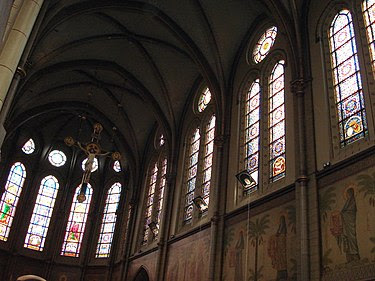Basilicas in Central Belgium
Basilica of the Sacred Heart, Berchem, Antwerp
Declared a minor basilica by Pope Pius IX in 1878—the first in Belgium.
The church claims to be the first basilica in the world dedicated to the Sacred Heart of Jesus. The stone basilica was built between 1875 and 1878 using a neo-Gothic architectural style.
All pictures are from Wikipedia.
Basilica of Our Lady of Scherpenheuvel, Scherpenheuvel, Flemish Brabant
Declared a minor basilica by Pope Pius XI in 1922.
At some point during or before the 16th Century, a shepherd found a statue of the Virgin Mary hanging in an oak tree. People soon came to the site seeking cures from illnesses and word of miracles quickly spread. In the 17th Century, the site received royal patronage and the small chapel on the site was replaced by the current Basilica. The Baroque church was built between 1609 and 1627. The church is in the shape of a heptagon with the main altar on the site of the oak tree with six chapels surrounding it. Altarpieces were designed by Theodoor van Loon. The church remains a major pilgrimage destination in Belgium.
All pictures are from Wikipedia.
St. Martin’s Basilica, Halle, Flemish Brabant
Declared a minor basilica by Pope Pius XII in 1946.
The Basilica was built between 1341 and 1467 and is dedicated to St. Martin of Tours. It is constructed of white sandstone and employs a Gothic design with Baroque elements. It has many works of art dating to the time of its construction, most notably a Black Madonna statue dating to the 13th Century, possibly originally owned by St. Elizabeth of Hungary. Annual processions have been held since 1335.
All pictures are from Wikipedia.
National Basilica of the Sacred Heart, Brussels
Declared a minor basilica by Pope Pius XII in 1952.
King Leopold II, inspired by the Basilica of Sacre Couer in Paris, decided to build a similar church in Brussels to commemorate 75 years of Belgian independence. Construction of the Art Deco church began in 1905 but was not completed until 1970 due to the two world wars. Made of brick, reinforced concrete, stone, and terracotta layering, the church can accommodate 3,500 people. The copper dome rises 292 feet above the ground.
The first picture is from Flickr and the others from Wikipedia.
Basilica of Our Lady of Hanswijk, Malines, Antwerp
Declared a minor basilica by Pope John Paul II in 1987.
A statue of Our Lady has attracted pilgrims since 988. The current Basilica was built between 1661 and 1683 and features an Italian façade and a Baroque interior with a stucco ceiling.
All pictures are from Wikipedia.
Abbatial Basilica of St. Servatius, Grimbergen, Flemish Brabant
Declared a minor basilica by Pope John Paul II in 1998.
Grimbergen Abbey is a Premonstratensian monastery that was established in 1128 to replace an Augustinian monastery. The Basilica, which is the Abbey church, was completed in 1660.
All pictures are from Wikipedia.
Basilica of Our Lady of Peace and Concord, Wavre, Walloon Brabant
Declared a minor basilica by Pope John Paul II in 1999.
The Basilica was built as part of a monastic complex in the 16th Century/17th Century on the ruins of a 11th Century Benedictine abbey. A statue of Our Lady dates to 1640 which has attracted pilgrims for centuries.
Both pictures are from Wikipedia.
Basilica of Our Lady of Consolation, Vilvoorde, Flemish Brabant
Declared a minor basilica by Pope Benedict XVI in 2006.
The Basilica is the church for a Carmelite monastery that dates back 800 years. The Baroque church was built in the 17th Century.
Pictures are from Pinterest and Wikipedia.
Basilica of Our Lady of Lourdes, Edegem, Antwerp
Declared a minor basilica by Pope Benedict XVI in 2008.
A local landowner built a replica of the Lourdes Grotto on his property in 1884 and soon pilgrims started visiting the site. The current church was built between 1931 and 1933 to meet the needs of the pilgrims. The neo-Byzantine style church has a 167-foot bell tower and copper Stations of the Cross.
From Wikipedia.

























No comments:
Post a Comment